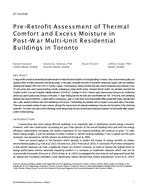-
-
Available Formats
- Options
- Availability
- Priced From ( in USD )
-
Available Formats
-
- Immediate download
- $16.00
- Add to Cart
Customers Who Bought This Also Bought
-

ST-16-C029 -- Pre-Retrofit Assessment of Thermal Comfort ...
Priced From $16.00 -

ST-16-C035 -- Opportunities and Obstacles in Residential,...
Priced From $16.00 -

ST-16-C064 -- Performance of a 4-RT RTU with R-410A Low-G...
Priced From $16.00 -

ST-16-C027 -- Accounting for Borehole Thermal Capacity wh...
Priced From $16.00
About This Item
Full Description
Recently, a surface coating was developed that when exposed to the sky during the day or at night, will passively cool itself below the ambient air temperature by a mechanism known as radiative sky cooling. In this mechanism, heat is emitted from the surface to the atmosphere as long-wave infrared radiation. Since the atmosphere is transparent to long-wave infrared radiation, the surface is able to exchange heat with the upper atmosphere, which is much colder than the ambient air temperature. Remarkably, this is an entirely passive and renewable mechanism that can be used to reject heat, even at temperatures below the ambient air temperature. Historically, this mechanism has only been accessible at night. However, in 2014 we demonstrated that a properly designed surface can achieve the same effect during the day; making radiative sky cooling possible even under direct sunlight, when demand for cooling is the greatest. In this paper, we assess the capability of a panel with a surface designed for daytime radiative sky cooling to passively cool water below the dry-bulb temperature with no evaporative water losses, where the only energy input is to pump water through the panel. An important application of these panels is to serve as a modular cooling tower. The panel can potentially provide comparable efficiencies to an evaporatively cooled chiller but with no water loss, and at smaller cooling capacities (<100 tons). To demonstrate the benefit of the cooling panels on a building's chiller system, we performed a thermodynamic analysis using the TMY3 dataset (typical meteorological data) from Las Vegas, NV and detail the benefit over a typical air cooled chiller in a medium sized office building.





